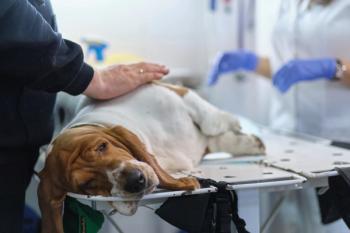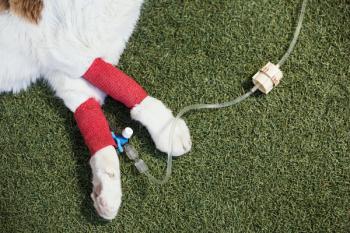
Drug shortages: The new norm for veterinary medicine?
Drug shortages are becoming more common, and the trend could be getting worse, veterinary officials report.
NATIONAL REPORT — Drug shortages are becoming more common, and the trend could be getting worse, veterinary officials report.
While there are only four medically necessary veterinary drugs in short supply, there are more than 200 human drugs that have been added to the endangered list. The trend poses a threat to patients and veterinarians, with shortages noted in multiple drug classes—from pain relievers to chemotherapeutics to antibiotics—and it may get worse.
Veterinarians are currently facing shortages of four medically necessary veterinary drugs—Levamisole HCI, Vetsulin, Epinephrine and Immiticide, according to the U.S. Food and Drug Administration. But for veterinary clinics that have to beg or borrow to get the supplies needed for patients, the situation is more dire.
Shortages of human-approved drugs are becoming more common, according to the Institute for Safe Medication Practices. And those shortages have a trickle-down effect on veterinarians who depend on their off-label uses.
"Veterinarians, in general, are compassionate people, and we like helping animals. Drug shortages make our day hard," says Ann Hohenhaus, DVM, Dipl. ACVIM (SAIM, Oncology) of The Animal Medical Center. "I don't think it's going to go away, either.
"We have fewer and fewer companies making drugs," she adds. "The system, the model, the process by which drugs are produced kind of set themselves up for this drug shortage thing."
Dinah Jordan, PharmD, DICVP, chief of pharmacy services and clinical professor at the Mississippi State University College of Veterinary Medicine, says the last two years have been particularly difficult in terms of drug shortages. According to FDA figures, there were more veterinary drug shortages in 2010 than in any other year, she says.
"2011 appears to be not much better," Jordan says.
"To be honest with you, it's very frustrating because we know we need these drugs. So, we go to the source; we can't find them. We go to alternates; we can't find them—and we have to start scrambling," says Arnold Sabino, director of materials management at The Animal Medical Center in New York City.
A vicious cycle, Sabino says the situation is made worse when shortages are anticipated and clinics start to stock up on certain drugs, depleting the stock for others.
The American Society of Health-System Pharmacists (ASHP) tracks more drug shortages than FDA, which only monitors those deemed medically necessary. It reports that more than 200 human drugs are now in short supply, with 19 no longer available and 102 recent shortages resolved.
Many of those drugs can and are used by veterinarians, says Jennifer Coates, DVM, of Home to Heaven, an in-home hospice and euthanasia practice in Fort Collins, Colo. Coates reports a number of shortages outside the four medically necessary veterinary products (MNVP) tracked by FDA. They include chemotherapy drugs like cisplatin and doxorubicin; antibiotics such as amikacin, azithromycin, ciprofloxacin, metronidazole and gentamicin; and pain relievers like buprenorphine and butorphanol. Also in shortage is acyclovir, an antiviral drug used to treat feline herpes infections; propofol, an injectable anesthetic; acetazolamide, used to treat glaucoma; aminophylline, used to relieve airway constriction; injectable atropine sulfate and glycopyrrolate, used to keep an animal's heart rate up during anesthesia; azathioprine, used in autoimmune therapies; bupivacaine with epinephrine, a local anesthetic often used in declawing procedures or for incisions; injectable diazepam, used in treating seizures; and injectable furosemide, used to reduce fluid build-up in the body.
Frank Alvarez, central supply supervisor at Animal Medical Center says the hospital is also currently facing shortages of lidocaine, norepinephrine and fentanyl injections.
Reasons for shortages
Why shortages occur is a difficult question to answer, but one that has many theories. Sometimes, not even pharma watchdogs can get answers.
In regard to shortages of fentanyl injections, ASHP says the shortage began Oct. 5. Some formulations of the analgesic have been discontinued, but West-Ward, which acquired Baxter's fentanyl injection products in May 2011 could not provide a reason for the shortage. Hospira reports its shortage is due to increased demand, according to ASHP. In the case of norepinephrine injections, ASHP cites a shortage date of Oct. 6, with reasons for the shortage ranging from manufacturer delays (Bedford), discontinuation (Teva) and increased demand (Hospira). FDA allowed a temporary importation from Canada to mitigate the shortage, ASHP says.
For MNVPs, the answers are similar. FDA says animal-drug shortages can result from unavailable raw materials, unavailable packing materials, marketing decisions by manufacturers and FDA enforcement issues. MNVPs are defined by FDA as drugs used to treat or prevent a serious animal disease or condition; drugs needed to assure the availability of safe food products originating from animals; or drugs that are available from only one source or for which no adequate substitutes are available.
Arnel B. Peralta, DVM, drug-shortage coordinator at FDA's Center for Veterinary Medicine, says the agency monitors possible drug shortages through interactions with veterinarians, pet owners and professional organizations, and through direct contact with drug manufacturers. Once a shortage is verified, FDA works with drug manufacturers in the United States and, when necessary, abroad, to find ways to resolve the shortages. But FDA can't require any company to make a product, Peralta adds.
Recent examples of FDA interventions in shortages of MNVPs include Vetsulin and Immiticide.
FDA announced in May 2010 that it would allow Intervet/Schering-Plough Animal Health to offer a limited supply of Vetsulin through a critical-need program. Only dogs and cats whose diabetes could not be managed on other insulin products would qualify for the program, FDA says. The shortage resulted from FDA's concern over the stability of the drug in November 2009. The product was ultimately discontinued in early 2011.
In the case of Immiticide, FDA announced it would allow Merial to import limited amounts of the European version of the drug, which is used to treat heartworm in dogs. The solution is temporary while Merial works out technical issues in the plant where Immiticide is manufactured, FDA says. However, the amount of imported Immiticide will not be enough to satisfy the domestic need for the drug, FDA cautions, and there is no word on when the shortage will be resolved.
The shortage of Levimasol HCI is attributed to a manufacturing site delay, and epinephrine shortages are due to discontinued distribution, according to FDA.
Many times, drug makers find themselves in shortage of raw materials because their suppliers are mostly, if not all, overseas, Jordan says. FDA must approve those suppliers, and sometimes there are issues there, she says.
"I think there are several things causing (drug shortages)," adds Hohenhaus. "There are fewer companies making generic drugs. If there are fewer companies maybe making as not a wide variety of drugs and their plant goes offline, there's a problem."
"And I think that there are very few veterinary drugs. We really depend on off-label. As more human drugs are shortaged, it affects us," she adds.
Many of the shortages in human-medicine products used by veterinarians are with older injectable drugs, Jordan explains. In those cases, manufacturers will often divert their supply lines to newer, more profitable drugs.
Profit plays a role in another theory as to why shortages occur. Sometimes, drugs fall off patent and become generic, and are no longer profitable for drug companies to produce, says Sabino.
"It's not cost-effective for them to produce them, and there's a lot of government regulations they don't want to put up with," Sabino says.
In those cases, opportunities to obtain the drugs may sometimes arise in alternate markets that drive the price up. People are willing to pay anything for the medications at that point. Hohenhaus says drugs will often go up drastically in price following a shortage.
"Sometimes, I think to myself that this might be one of the reasons we are having these shortages, so they can get the right pricing to make it cost-effective to produce," Sabino says.
What to do during a shortage
Unfortunately, in the case of MNVP shortages, there are likely no alternatives to fill the void.
Sabino says it leaves veterinarians and physicians alike in the position of having to find alternative drug therapies, and that is not always possible.
"We feel just as helpless (as the veterinarians)," Sabino says.
"They do their best to come up with an alternative, but it may not be as not as good as the drug originally prescribed," Alvarez adds. "It might not work as effectively as the real drug, the original drug."
Hohenhaus says The Animal Medical Center develops protocols when drug shortages are anticipated, researching alternative drugs and therapies that could be used. In the case of the doxarubicin shortage, she and her colleagues identified a cousin drug that could work for treatment. Fortunately, the shortage never hit The Animal Medical Center, she says. But a remedy for dogs suffering from allergies in their ears, Synotic, has been backordered for a long time, and Hohenhaus says she has gotten creative in finding alternatives. She recently sent a client home with a similar formulation of eye drops, with instructions to place the drops in the dog's ear for relief. Substituting similar drugs is often preferred over compounding medications, she adds.
Veterinarians may find themselves having to trade or borrow from colleagues, but oftentimes in a shortage, many people will hold on to whatever supply they have, Alvarez says.
Jordan says for drugs where the raw ingredient can still be obtained, compounding pharmacies may help ease a shortage. But in many cases, there are no alternative drugs but only inferior therapies, Jordan says.
In Immiticide's case, the American Heartworm Society unveiled an interim management plan that includes maintaining the health of the heartworm-positive dog until it can be appropriately treated, pre-treatment of heartworm-positive dogs to prevent shock, careful administration of a macrocyclic lactone heartworm preventive followed by clinical observation for at least eight hours, continuous administration of a heartworm preventive on the regular dosing schedule, administration of doxycycline on a one-month-on/two-months-off schedule, restricted activity and exercise and medical treatment of symptomatic heartworm infection to relieve signs of respiratory disease.
The University of Florida College of Veterinary Medicine (UF) also is offering an alternative treatment in the absence of Immiticide—surgical extraction of the heartworms. The treatment could benefit dogs with extensive disease, according to UF. The process involves veterinary cardiologists surgically extracting the worms using specialized instruments inserted just into the right side of the heart and pulmonary arteries through the jugular vein on the side of the neck.
"This minimally invasive technique is deemed most valuable as an option for dogs with considerable symptoms or high levels of heartworms," says Herb Maisenbacher, VMD, a clinical assistant professor in cardiology at UF's College of Veterinary Medicine. "In this way, the heartworms are physically removed from the dog...
"The procedure is not risk-free, because it involves heavy sedation or general anesthesia and is not inexpensive," he adds. "But for dogs with extensive disease, it could be another option to consider at a time when there is no other available treatment."
Jordan says these less-than-ideal alternatives are challenging for practitioners.
"I have clinicians who have come and said, 'What am I going to do?' Then you have to just start looking for alternative drugs that might not be as good for what you're treating and that's very frustrating for practitioners and pharmacists," she says.
The role of regulators
Since FDA can't require manufacturers to keep producing any particular drug, the regulatory agency is limited in ways it can mitigate drug shortages.
In the case of MNVP shortages, Peralta says FDA creates an action plan, which may include holding discussions with manufacturers and others in the animal-health industry, speeding up the animal drug-review and approval process, and exercising enforcement discretion by opting to not strictly enforce approval requirements found in the Federal Food, Drug and Cosmetic Act.
FDA has not changed any policies surrounding the management of MVNPs as a result of shortages but did respond to the problem by appointing Peralta to the position of full-time drug-shortage coordinator in January 2011.
The agency tries to keep watch and prevent shortages but says manufacturers are not required by law to notify federal regulators of impending shortages.
Even when shortages can be resolved, though, there are often problems with the price of the newly restored drug stock. Jordan says she has seen prices increase by several hundred percent after shortages are resolved.
But if a drug shortage becomes a reality, she says practitioners should contact their local veterinary medical association or veterinary college for assistance in identifying alternative suppliers in some shortage situations.
Hohenhaus also suggests taking cues from colleagues for solutions.
"When you go to meetings and (events), listen to what colleagues are saying and ask how they are handling shortages. Listen to the drug reps," she says. "Pay attention to what's out there and talk to people."
Newsletter
From exam room tips to practice management insights, get trusted veterinary news delivered straight to your inbox—subscribe to dvm360.





